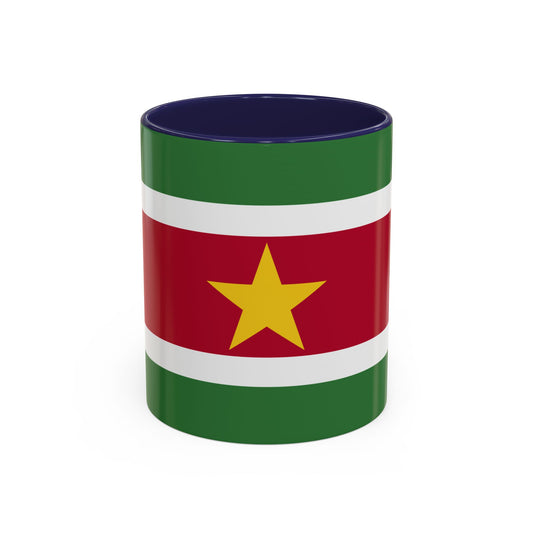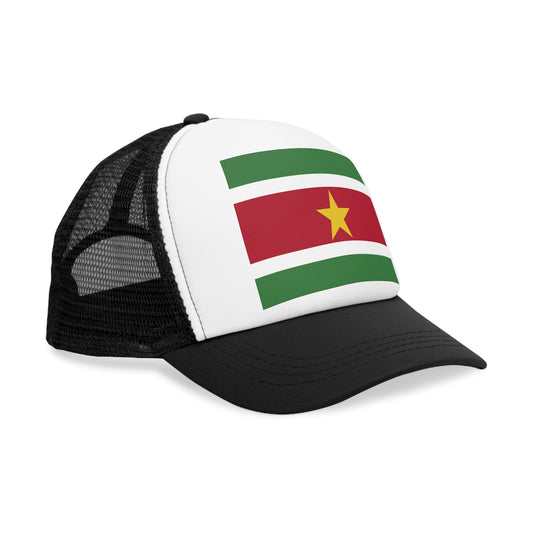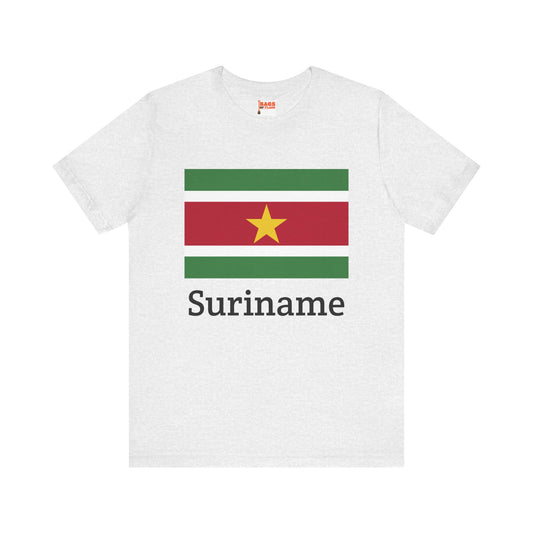-
Suriname Sweatshirt
Regular price $34.15 USDRegular priceUnit price / per -
Suriname Flag Sweatshirt
Regular price $34.15 USDRegular priceUnit price / per -
Suriname Pillow
Regular price $22.65 USDRegular priceUnit price / per -
Suriname Backpack
Regular price $59.79 USDRegular priceUnit price / per -
Suriname Leather Patch Hat
Regular price $18.85 USDRegular priceUnit price / per -
Suriname Mug
Regular price $8.65 USDRegular priceUnit price / per -
Suriname Trucker Cap
Regular price $14.90 USDRegular priceUnit price / per -
Suriname Hoodies
Regular price $34.40 USDRegular priceUnit price / per -
Suriname T-shirts
Regular price $22.79 USDRegular priceUnit price / per -
Suriname Flag Hoodies
Regular price $34.40 USDRegular priceUnit price / per -
Suriname Flag on T-shirt
Regular price $22.79 USDRegular priceUnit price / per
Collection: Suriname
The Suriname flag, also known as the flag of Suriname, symbolizes the country's identity and history. Its design, colors, and symbolism hold significant meaning for the people of Suriname. We will explore the story behind the Suriname flag, covering its design, historical context, symbolism, current relevance, and additional interesting facts.
Overview of the Suriname Flag's Design and Colors

The flag of Suriname showcases a distinct and thoughtful design comprised of five horizontal bands. At the top and bottom, green stripes encapsulate the spirit of vitality and optimism for the nation's future. Between these verdant bands lie two narrower white stripes, epitomizing the ideals of peace and justice foundational to the Surinamese society. Central to the flag is a broader red stripe, which is the heart of the flag's design, symbolizing the fervor of progress and the deep love for the homeland that resonates within the Surinamese people.
Crowning the red stripe is a yellow five-pointed star positioned in the center. This star serves as a beacon of unity and light, guiding the nation's diverse cultures towards a common purpose. This harmonious combination of colors and emblems reflects Suriname's rich environmental landscape and cultural heritage and encapsulates the nation's aspirations and commitment to progress and harmony.
Historical Context of the Suriname Flag
The historical journey of the Suriname flag is intertwined with the country's quest for independence and a distinct national identity. Officially adopted on November 25, 1975, the flag symbolized the newly independent nation following its separation from Dutch colonial rule. This date not only marked the birth of the Suriname flag but also celebrated the country’s step into sovereignty following intense negotiations and a push for self-governance. The flag’s design resulted from a nationwide contest to capture the essence of Suriname’s spirit, landscape, and people.
Jacques Herman Pinas, whose submission won, crafted a flag representing Suriname's aspirations, diversity, and unity. The adoption process was a critical moment for Suriname, symbolizing a break from colonial ties and the beginning of a new era in the country's history. The flag was designed to embody the values and hopes of all Surinamese, aiming to unite various ethnic and cultural groups under a common national symbol. This pivotal moment in Suriname's history underlined its commitment to fostering a cohesive national identity while embracing its multifaceted cultural heritage.
Symbolism Behind the Suriname Flag

Each element of the Suriname flag carries a profound significance that encapsulates the nation's ethos and aspirations. The green stripes bordering the flag symbolize Suriname's rich, fertile landscapes, a nod to the country’s abundant natural resources and commitment to environmental conservation. These stripes also mirror the hope and vigor of the nation's outlook toward a prosperous future. The white bands that separate the green from the central red stripe embody the principles of justice and freedom, pillars upon which Surinamese society stands. These stripes highlight the importance of peace and righteousness in facilitating the nation’s growth and unity.
At the flag's core, the red stripe is a testament to the bravery and sacrifice of those who fought for the country's independence and progress. It underscores the love and passion that the people of Suriname hold for their country, reflecting a collective spirit of resilience. Central to the flag, the yellow star shines as a symbol of unity and hope. It represents the light that guides the country's diverse ethnic groups towards a shared future, emphasizing the strength found in unity. This star also underscores Suriname's sovereignty and the bright prospects. Together, these elements weave a narrative of a nation deeply rooted in its past yet ambitiously looking forward to a harmonious and flourishing future.
Current Relevance of the Suriname Flag
Today, the Suriname flag holds a place of honor and significance in the nation's collective identity. It is a frequent fixture on various occasions, from state ceremonies to local festivals, symbolizing the unity and aspirations of the Surinamese people. Its presence in military parades and commemorations reflects the respect and reverence for those who have contributed to the nation's independence and ongoing development. In educational settings, the flag fosters a sense of national pride among students, serving as a visual reminder of their shared heritage and values.
Despite occasional debates over its representation of Suriname's diverse culture, the flag remains a powerful symbol of the country's unity and sovereignty. Discussions surrounding the flag's design and symbolism are indicative of the vibrant democracy and freedom of expression that exists in Suriname, illustrating the flag's role not just as a national emblem but as a catalyst for dialogue and reflection on the nation's identity and future direction.
Additional Facts About the Suriname Flag
Beyond its symbolic significance and daily appearances, the Suriname flag is governed by specific protocols that underscore its importance to the nation. These guidelines ensure the flag is respected and displayed properly, reinforcing its status as a national emblem. For instance, it is a tradition that the flag must be hoisted at sunrise and lowered at sunset, reflecting the respect and reverence it commands. This practice ensures that the flag is not left to endure the darkness, symbolizing the nation's perpetual strive towards light and progress.
In formal settings, the Suriname flag is often seen in a place of prominence, often flanked by the flags of other nations or important organizations. This not only showcases Suriname's sovereignty but also its willingness to engage and cooperate with the global community, reflecting its position in the world.
Additionally, the flag's presence extends beyond official buildings and ceremonies. It is a familiar sight in educational environments where it serves as a daily reminder to students of their country's unity and values. This constant visibility in public spaces and institutions plays a crucial role in embedding a sense of national pride and identity among the Surinamese people. The protocols surrounding the flag's display, therefore, not only honor its significance but also facilitate a deeper connection between the flag and the people of Suriname, weaving it into the fabric of daily life.






















